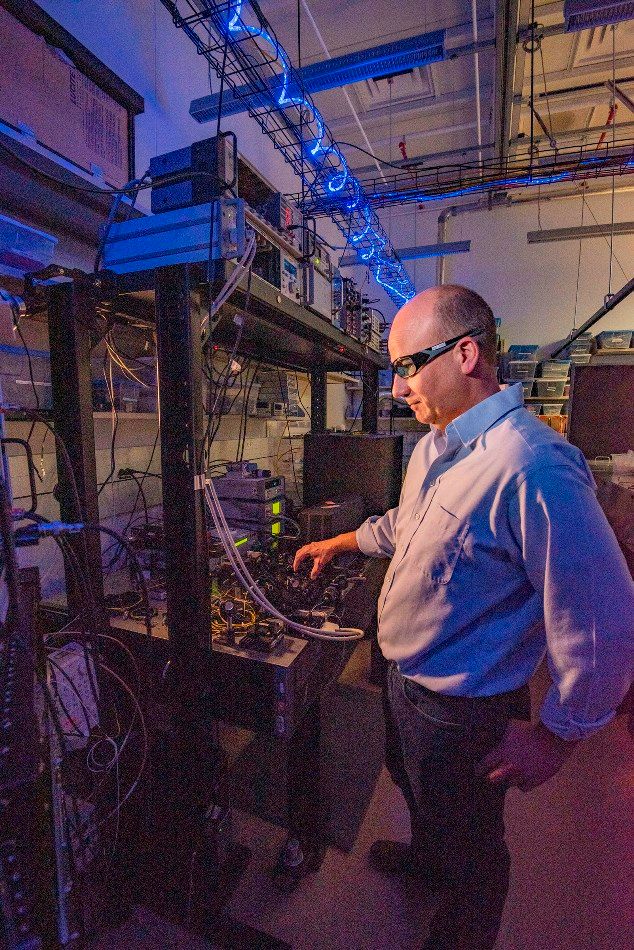Dec 23 2019
In the 1990s, the National Institute of Standards and Technology (NIST) developed its first superconducting devices to count photons (the smallest units of light). Since then, these previously uncommon detectors have become well-known research tools across the globe.
 As part of a research project to help establish standards for photon-counting detectors, NIST physicist Thomas Gerrits adjusts the laser beam hitting a detector. The squiggly overhead light helps researchers see the lab setup without disturbing the detectors, which are insensitive to blue light. Image Credit: J. Burrus/NIST.
As part of a research project to help establish standards for photon-counting detectors, NIST physicist Thomas Gerrits adjusts the laser beam hitting a detector. The squiggly overhead light helps researchers see the lab setup without disturbing the detectors, which are insensitive to blue light. Image Credit: J. Burrus/NIST.
Currently, the NIST has been making efforts to enable universal standards for these devices, which are turning out to be more and more crucial in industry and science.
At present, single-photon detectors (SPDs) are vital to research areas spanning from astrophysics and optical communications to groundbreaking information technologies based on quantum physics, like quantum teleportation and quantum cryptography.
It is essential for SPDs to be assessed and compared to a specific benchmark, preferably a formal standard, to guarantee that they are reliable and accurate. Scientists at NIST are creating techniques to perform that and have already begun conducting custom calibrations for the few companies that develop SPDs.
Recently, the NIST researchers published techniques for evaluating the efficiency of five SPDs, which include one developed at NIST, as a precursor to providing an official calibration service.
This is a first step towards implementation of a quantum standard—we produced a tool to verify a future single-photon detection standard. There is no standard right now, but many national metrology institutes, including NIST, are working on this.
Thomas Gerrits, Physicist, NIST
“There have been journal papers on this topic before, but we did in-depth uncertainty analyses and described in great detail how we did the tests,” added Gerrits. “The aim is to serve as a reference for our planned calibration service.”
NIST is exclusively qualified to create these evaluation techniques since the institute creates the most efficient SPDs across the globe and has also been constantly optimizing their performance. The institute specializes in two different superconducting designs—one is based on nanostrips or nanowires, assessed in the new research, and the other one is based on transition-edge sensors, which will be evaluated in the near future.
Future studies may also deal with standards for detectors that quantify very low levels of light but do not have the ability to count the number of photons.
In the modern metric system, called the SI system of units, candela is the basic unit of measurement most closely associated with photon detection. This unit is relevant to light detected by the human eye. New SI redefinitions may incorporate photon-counting standards, which could provide a more precise way of measuring light in terms of candela. In existing standards, single-photon light levels fall below one-billionth of the amounts.
The new study describes the use of traditional methodologies at NIST to quantify SPD detection efficiency, which is defined as the probability of detection of a photon that hits the detector and produces a quantifiable outcome. The NIST researchers made sure that the measurements were traceable to a basic standard for optical power meters (Laser Optimized Cryogenic Radiometer from NIST).
The meters preserve precision as measurements are scaled down to low levels of light, where the overall measurement uncertainty is mainly caused by the power meter calibration.
The team quantified the efficiencies of five detectors—including NIST’s nanowire detector and three silicon photon-counting photodiodes. For some measurements, photons were sent through optical fiber, and in other cases, they were sent through the air.
Measurements were performed for two distinct wavelengths of light generally used in fiber optics and communications. Uncertainties varied from as low as 0.70% for measurements in fiber at 1533.6 nm wavelength, to 1.78% for over-the-air readings at a wavelength of 851.7 nm.